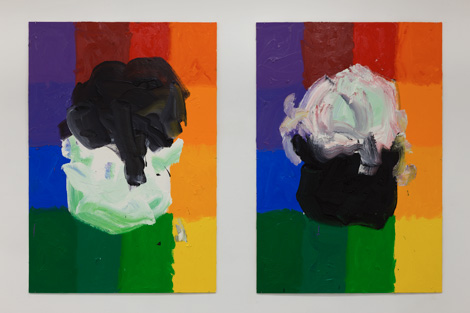This survey of Al Payne’s work goes back a half century and spans his entire career, establishing the late artist as an assured painter and colorist, no matter what his subject matter or his style: figurative or abstract, conceptual or retinal. That is, the survey would establish Payne as all that, if only the bulk of its contents were visible. Only several small oils, works on paper, and a conceptual object or two, all dating from the last year or so of his life, can be seen; the rest of the show, such as it is, hides in two large wooden sheds planted in the gallery’s capacious center room.
This setup turns the show’s nucleus into a realization of a performance piece Payne conjured around his work, a kind of meta-artwork that simultaneously summarizes and secretes nearly his entire output. The pieces we can see were realized mostly in Paris, where Payne moved after the breakup of his marriage. Many of these are crude, self-pitying cartoons lamenting his alienated circumstance; they don’t add up to much visually, but their pathos, excessive as it is, becomes affecting through sheer repetition.
This is what renders this exhibition so irksome: It could vouch for Payne as an artist of broad and impressive accomplishment, if only it would allow us a glimpse of that accomplishment. Instead, all those canvases and objects are sealed up in those two damned sheds, concentrating instead, as the exhibit’s narrative put it, on “a glimpse into [Payne’s] state of mind in the last two years of his life,” that is, the moment he left his family and country, only to return to California and succumb to cancer. When he left Bolinas, he sealed his entire oeuvre in the two sheds he’d built 30 years earlier—and decided that the sheds themselves were art objects and should be shown as such. Payne’s friend Paul McCarthy agreed to display them thus in a show McCarthy curated in San Francisco, a show Payne did not live to see. But Payne told McCarthy of a dream he’d had of the paintings being carried one by one, and, by chance, that dream became post-mortem reality.

Al Payne, ISOOUPFEHBWHELADOE #1 (Diptych), 2007. Courtesy of The Box, LA and Chris Payne. Photo by Fredrik Nilsen.
By design, the dream has become reality in—and crucial to—this show. During the exhibit’s opening reception the paintings were indeed marched from truck to shed. The only people who saw them were attending the opening at that instant. On the show’s last day, the process will be repeated, in reverse. For one brief shining moment, an Al Payne retrospective (of sorts) will again see the light of day. Meanwhile, a few charming or pitiable gestures dot the gallery while those two sheds sit there, mocking our attempts to “know” Payne through his art. Whether you regard this strategy as foolishly self-abnegating or as brilliantly noble, it is Payne’s strategy, no one else’s.


